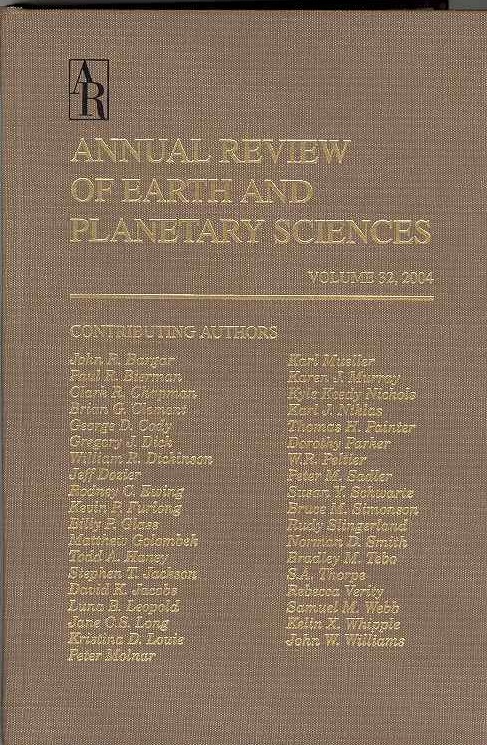Subaerial Emergence of Continents on Archean Earth
IF 13
1区 地球科学
Q1 ASTRONOMY & ASTROPHYSICS
Annual Review of Earth and Planetary Sciences
Pub Date : 2025-02-20
DOI:10.1146/annurev-earth-040722-093345
引用次数: 0
Abstract
The emergence of continental crust above sea level influences Earth's surface environments and climate patterns, and it creates diverse habitats that promote biodiversity. Earth exhibits bimodal hypsometry with elevated continents and a submerged seafloor. However, it remains elusive when and how this unique feature was first established. The geological record suggests the presence of subaerial landmasses between ca. 3.8 and 2.4 billion years ago (Ga), but their spatial extent and longevity remain unclear. Further, the tectonic processes governing the proportion of continental land to ocean basins and topography during this period are poorly understood. Here, we synthesize a variety of geological and geochemical proxies to suggest that crustal emergence did occur in the early-to-mid Archean, primarily exposing precratonized volcanic crust for brief time periods. Stable continental crust on a regional scale (as cratons) began emerging around ca. 3.2–3.0 Ga, facilitated by the development of thick, stable cratonic lithospheres. Over hundreds of millions of years, voluminous magmatism within a plateau-type setting led to the formation of thick, felsic crust and depleted mantle keels, allowing cratons to rise above sea level via isostatic adjustment. The areal extent of emergent land increased from ca. 3.0 to 2.5 Ga owing to the formation of more cratons, likely coinciding with the onset of plate tectonics, and culminated around ca. 2.5–2.2 Ga when land surface area and freeboard conditions resembled those observed today. These newly emerged landmasses possibly played a critical role in oxygenating the atmosphere and oceans, cooling the climate, and promoting biodiversity during the late Archean to early Paleoproterozoic.太古宙大陆的陆上出现
海平面以上大陆地壳的出现影响了地球表面环境和气候模式,并创造了促进生物多样性的多样化栖息地。地球呈现出大陆隆起和海底下沉的双峰性地形。然而,这种独特的特征是何时以及如何建立起来的,仍然难以捉摸。地质记录表明,大约38亿至24亿年前(Ga)之间存在陆上地块,但其空间范围和寿命尚不清楚。此外,在这一时期,控制大陆与海洋盆地比例和地形的构造过程也知之甚少。综合各种地质和地球化学指标,我们认为太古宙早中期确实发生过地壳出露,主要是在短时间内暴露出前宙化的火山地壳。稳定的区域大陆地壳(如克拉通)在大约3.2-3.0 Ga左右开始出现,这得益于厚而稳定的克拉通岩石圈的发展。几亿年来,在高原类型的环境中,大量的岩浆作用形成了厚厚的长英质地壳和枯竭的地幔龙骨,使克拉通通过均衡调整上升到海平面以上。由于更多克拉通的形成(可能与板块构造的开始相吻合),从约3.0 Ga到2.5 Ga,新兴陆地的面积范围增加,并在约2.5 - 2.2 Ga左右达到顶峰,此时陆地表面面积和干舷条件与今天观察到的相似。在太古宙晚期到古元古代早期,这些新出现的陆地可能在给大气和海洋充氧、冷却气候和促进生物多样性方面发挥了关键作用。■大陆的出现标志着地球历史上的一个关键时刻,影响着地球的大气、海洋、气候和生命进化。▪我们回顾了岩石记录,以推断地球早期大陆出现的时间、性质和构造驱动因素。▪太古宙早期地球的出现大多是短暂的,主要暴露火山地壳。▪第一个稳定的大陆板块形成于约3.2-3.0 Ga,这是由于厚克拉通的发育及其均衡调整所致。▪随着更多克拉通的形成和板块构造的开始,从约3.0至2.5 Ga出现的陆地面积增加。
本文章由计算机程序翻译,如有差异,请以英文原文为准。
求助全文
约1分钟内获得全文
求助全文
来源期刊

Annual Review of Earth and Planetary Sciences
地学天文-地球科学综合
CiteScore
25.10
自引率
0.00%
发文量
25
期刊介绍:
Since its establishment in 1973, the Annual Review of Earth and Planetary Sciences has been dedicated to providing comprehensive coverage of advancements in the field. This esteemed publication examines various aspects of earth and planetary sciences, encompassing climate, environment, geological hazards, planet formation, and the evolution of life. To ensure wider accessibility, the latest volume of the journal has transitioned from a gated model to open access through the Subscribe to Open program by Annual Reviews. Consequently, all articles published in this volume are now available under the Creative Commons Attribution (CC BY) license.
 求助内容:
求助内容: 应助结果提醒方式:
应助结果提醒方式:


